Finance Report: Australian IPO Performance and Underpricing
VerifiedAdded on 2021/05/27
|16
|3714
|155
Report
AI Summary
This report provides a comprehensive analysis of Initial Public Offerings (IPOs) in the Australian market, examining the initial returns generated from various sectors, including Real Estate, Telecommunications, Financials, Healthcare, Information Technology, and Consumer Discretionary. The report utili...
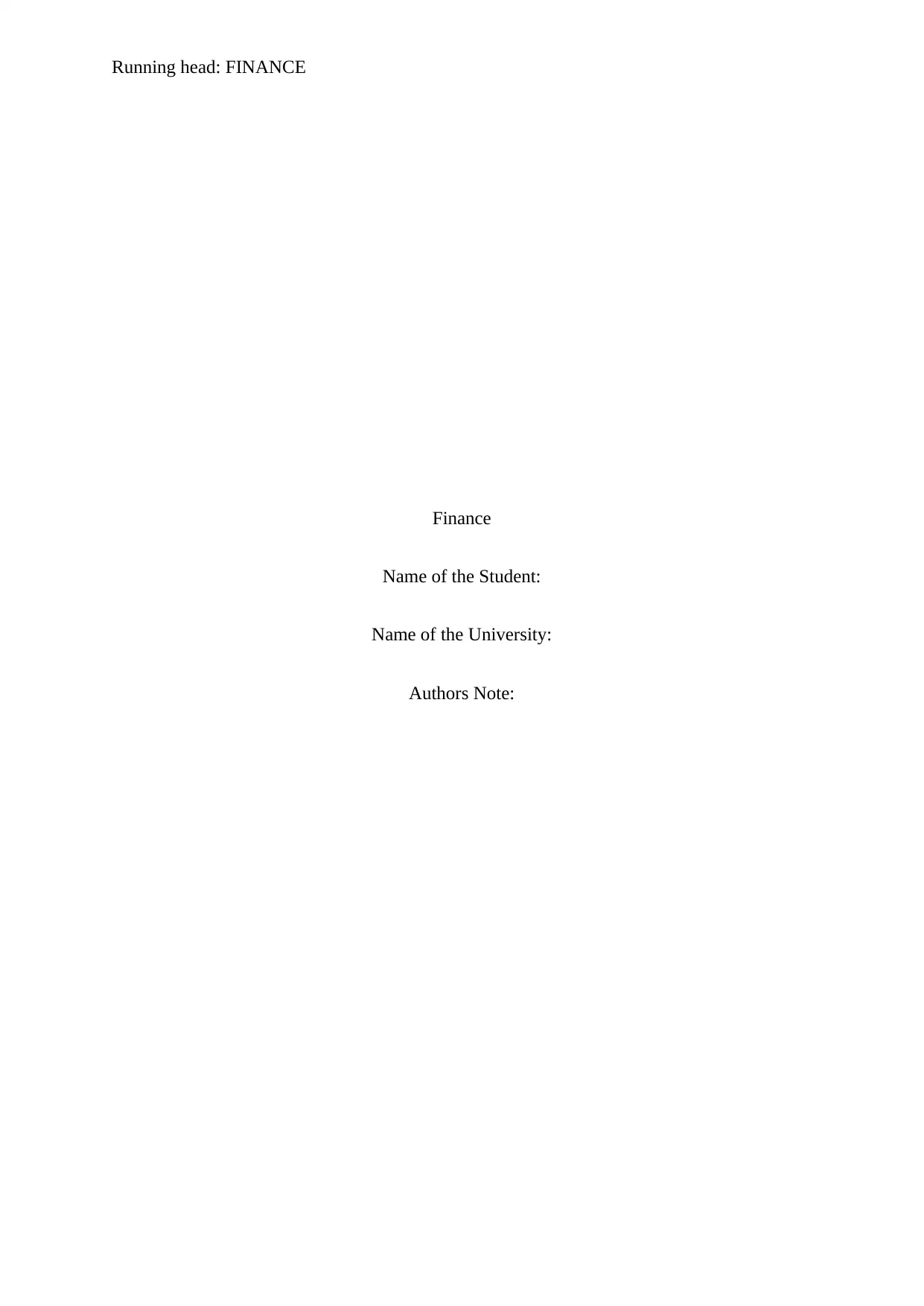
Running head: FINANCE
Finance
Name of the Student:
Name of the University:
Authors Note:
Finance
Name of the Student:
Name of the University:
Authors Note:
Paraphrase This Document
Need a fresh take? Get an instant paraphrase of this document with our AI Paraphraser
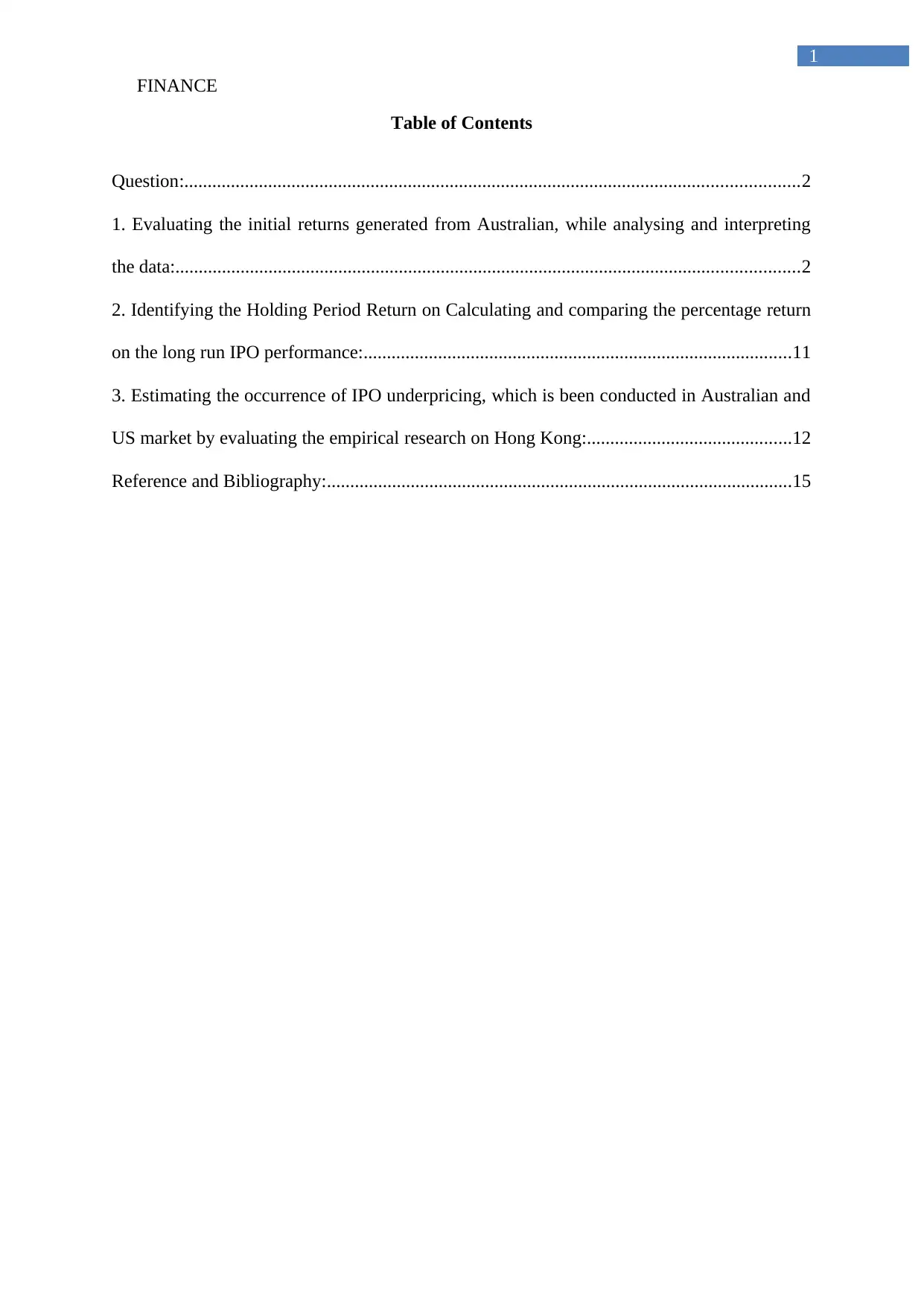
FINANCE
1
Table of Contents
Question:....................................................................................................................................2
1. Evaluating the initial returns generated from Australian, while analysing and interpreting
the data:......................................................................................................................................2
2. Identifying the Holding Period Return on Calculating and comparing the percentage return
on the long run IPO performance:............................................................................................11
3. Estimating the occurrence of IPO underpricing, which is been conducted in Australian and
US market by evaluating the empirical research on Hong Kong:............................................12
Reference and Bibliography:....................................................................................................15
1
Table of Contents
Question:....................................................................................................................................2
1. Evaluating the initial returns generated from Australian, while analysing and interpreting
the data:......................................................................................................................................2
2. Identifying the Holding Period Return on Calculating and comparing the percentage return
on the long run IPO performance:............................................................................................11
3. Estimating the occurrence of IPO underpricing, which is been conducted in Australian and
US market by evaluating the empirical research on Hong Kong:............................................12
Reference and Bibliography:....................................................................................................15
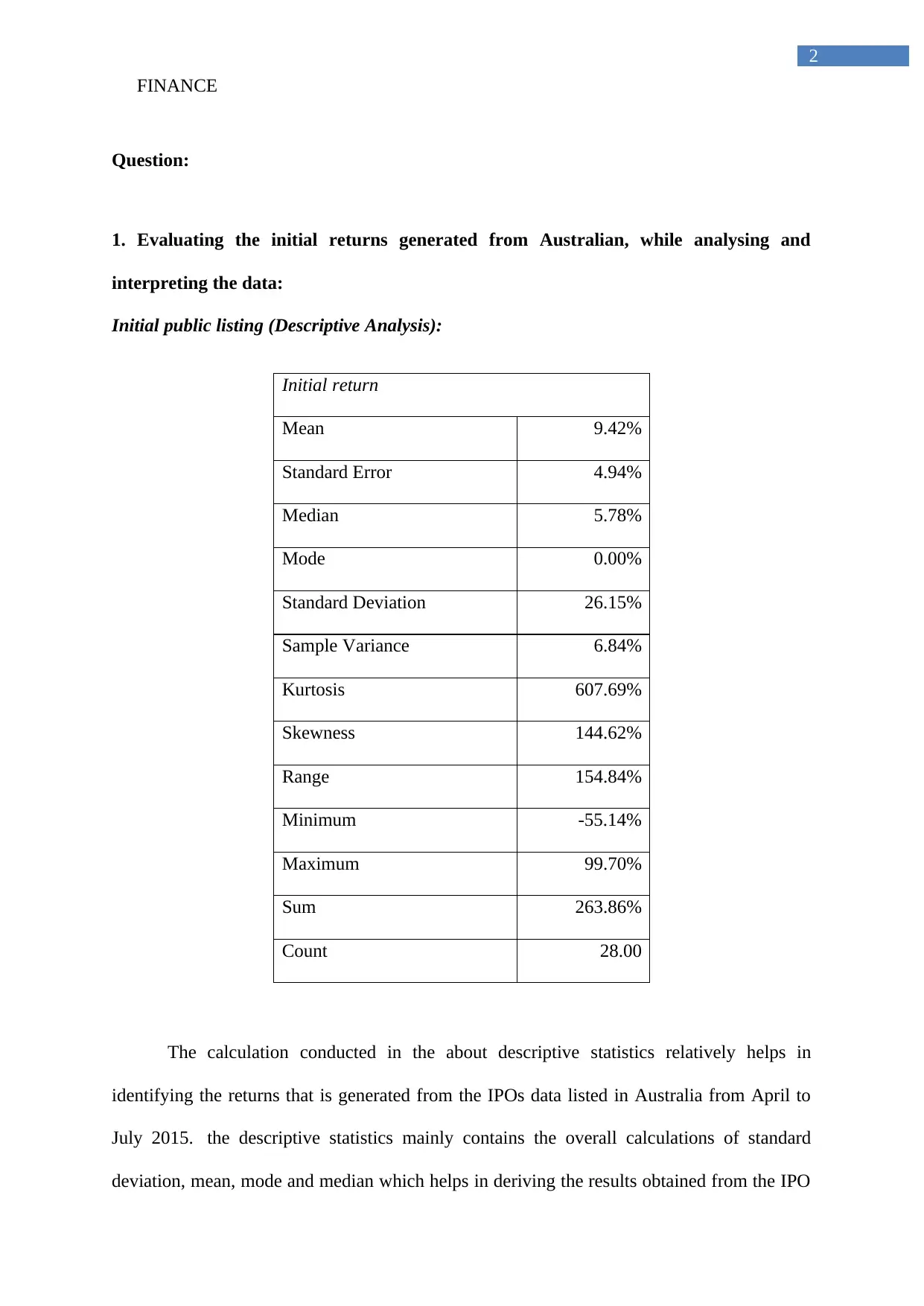
FINANCE
2
Question:
1. Evaluating the initial returns generated from Australian, while analysing and
interpreting the data:
Initial public listing (Descriptive Analysis):
Initial return
Mean 9.42%
Standard Error 4.94%
Median 5.78%
Mode 0.00%
Standard Deviation 26.15%
Sample Variance 6.84%
Kurtosis 607.69%
Skewness 144.62%
Range 154.84%
Minimum -55.14%
Maximum 99.70%
Sum 263.86%
Count 28.00
The calculation conducted in the about descriptive statistics relatively helps in
identifying the returns that is generated from the IPOs data listed in Australia from April to
July 2015. the descriptive statistics mainly contains the overall calculations of standard
deviation, mean, mode and median which helps in deriving the results obtained from the IPO
2
Question:
1. Evaluating the initial returns generated from Australian, while analysing and
interpreting the data:
Initial public listing (Descriptive Analysis):
Initial return
Mean 9.42%
Standard Error 4.94%
Median 5.78%
Mode 0.00%
Standard Deviation 26.15%
Sample Variance 6.84%
Kurtosis 607.69%
Skewness 144.62%
Range 154.84%
Minimum -55.14%
Maximum 99.70%
Sum 263.86%
Count 28.00
The calculation conducted in the about descriptive statistics relatively helps in
identifying the returns that is generated from the IPOs data listed in Australia from April to
July 2015. the descriptive statistics mainly contains the overall calculations of standard
deviation, mean, mode and median which helps in deriving the results obtained from the IPO
You're viewing a preview
Unlock full access by subscribing today!
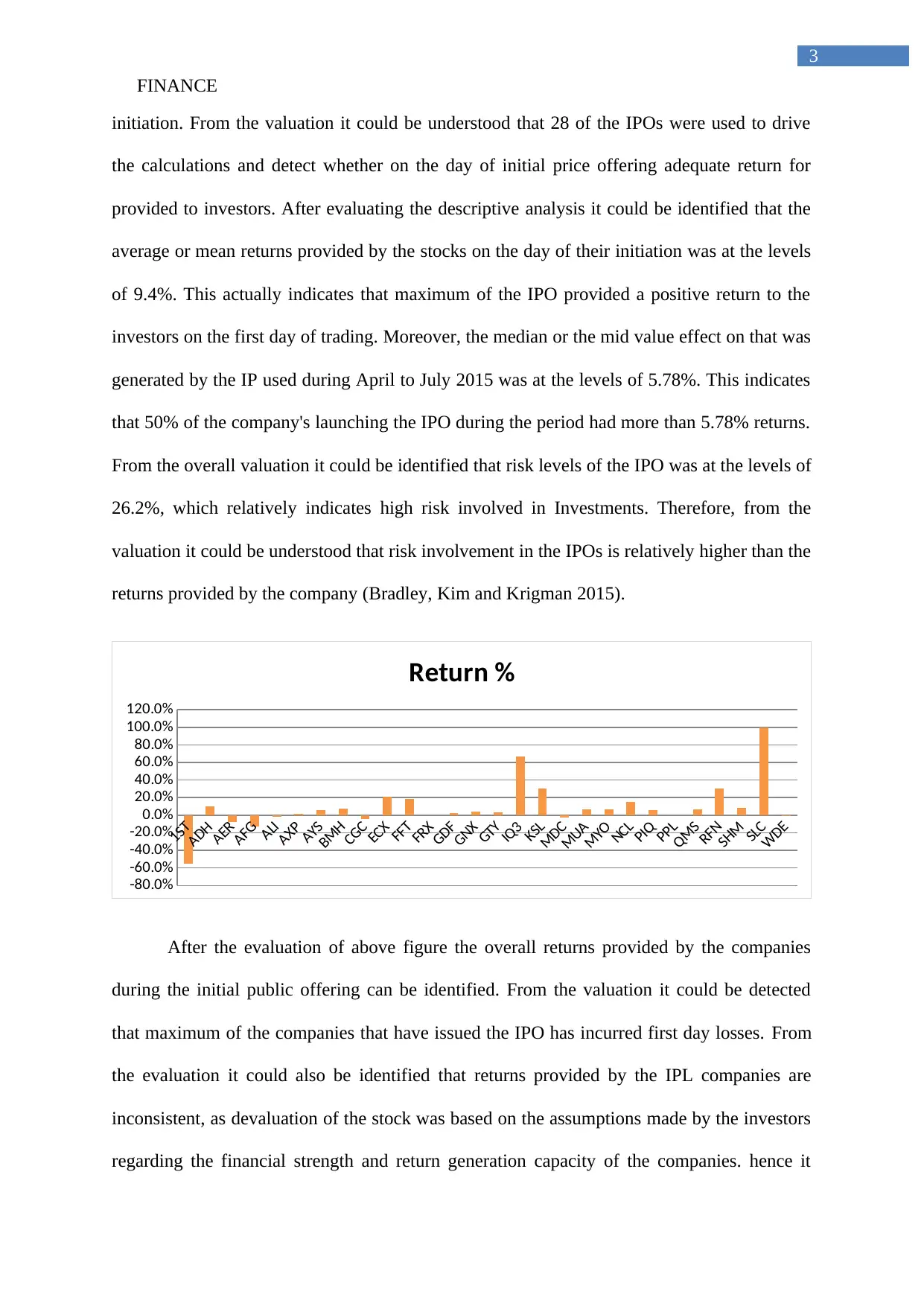
FINANCE
3
initiation. From the valuation it could be understood that 28 of the IPOs were used to drive
the calculations and detect whether on the day of initial price offering adequate return for
provided to investors. After evaluating the descriptive analysis it could be identified that the
average or mean returns provided by the stocks on the day of their initiation was at the levels
of 9.4%. This actually indicates that maximum of the IPO provided a positive return to the
investors on the first day of trading. Moreover, the median or the mid value effect on that was
generated by the IP used during April to July 2015 was at the levels of 5.78%. This indicates
that 50% of the company's launching the IPO during the period had more than 5.78% returns.
From the overall valuation it could be identified that risk levels of the IPO was at the levels of
26.2%, which relatively indicates high risk involved in Investments. Therefore, from the
valuation it could be understood that risk involvement in the IPOs is relatively higher than the
returns provided by the company (Bradley, Kim and Krigman 2015).
1ST
ADH
AER
AFG
ALI
AXP
AYS
BMH
CGC
ECX
FFT
FRX
GDF
GNX
GTY
IQ3
KSL
MDC
MUA
MYO
NCL
PIQ
PPL
QMS
RFN
SHM
SLC
WDE
-80.0%
-60.0%
-40.0%
-20.0%
0.0%
20.0%
40.0%
60.0%
80.0%
100.0%
120.0%
Return %
After the evaluation of above figure the overall returns provided by the companies
during the initial public offering can be identified. From the valuation it could be detected
that maximum of the companies that have issued the IPO has incurred first day losses. From
the evaluation it could also be identified that returns provided by the IPL companies are
inconsistent, as devaluation of the stock was based on the assumptions made by the investors
regarding the financial strength and return generation capacity of the companies. hence it
3
initiation. From the valuation it could be understood that 28 of the IPOs were used to drive
the calculations and detect whether on the day of initial price offering adequate return for
provided to investors. After evaluating the descriptive analysis it could be identified that the
average or mean returns provided by the stocks on the day of their initiation was at the levels
of 9.4%. This actually indicates that maximum of the IPO provided a positive return to the
investors on the first day of trading. Moreover, the median or the mid value effect on that was
generated by the IP used during April to July 2015 was at the levels of 5.78%. This indicates
that 50% of the company's launching the IPO during the period had more than 5.78% returns.
From the overall valuation it could be identified that risk levels of the IPO was at the levels of
26.2%, which relatively indicates high risk involved in Investments. Therefore, from the
valuation it could be understood that risk involvement in the IPOs is relatively higher than the
returns provided by the company (Bradley, Kim and Krigman 2015).
1ST
ADH
AER
AFG
ALI
AXP
AYS
BMH
CGC
ECX
FFT
FRX
GDF
GNX
GTY
IQ3
KSL
MDC
MUA
MYO
NCL
PIQ
PPL
QMS
RFN
SHM
SLC
WDE
-80.0%
-60.0%
-40.0%
-20.0%
0.0%
20.0%
40.0%
60.0%
80.0%
100.0%
120.0%
Return %
After the evaluation of above figure the overall returns provided by the companies
during the initial public offering can be identified. From the valuation it could be detected
that maximum of the companies that have issued the IPO has incurred first day losses. From
the evaluation it could also be identified that returns provided by the IPL companies are
inconsistent, as devaluation of the stock was based on the assumptions made by the investors
regarding the financial strength and return generation capacity of the companies. hence it
Paraphrase This Document
Need a fresh take? Get an instant paraphrase of this document with our AI Paraphraser
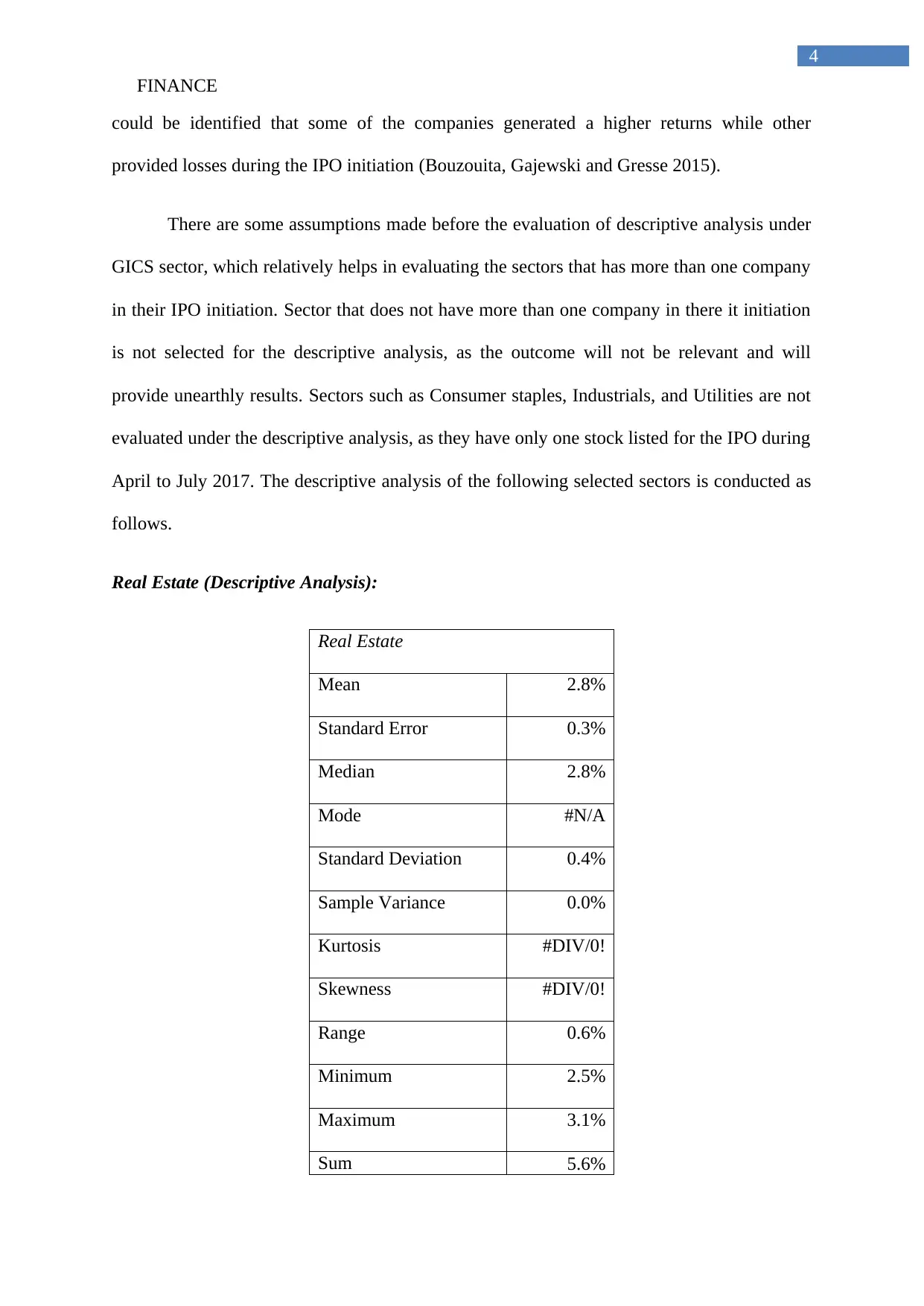
FINANCE
4
could be identified that some of the companies generated a higher returns while other
provided losses during the IPO initiation (Bouzouita, Gajewski and Gresse 2015).
There are some assumptions made before the evaluation of descriptive analysis under
GICS sector, which relatively helps in evaluating the sectors that has more than one company
in their IPO initiation. Sector that does not have more than one company in there it initiation
is not selected for the descriptive analysis, as the outcome will not be relevant and will
provide unearthly results. Sectors such as Consumer staples, Industrials, and Utilities are not
evaluated under the descriptive analysis, as they have only one stock listed for the IPO during
April to July 2017. The descriptive analysis of the following selected sectors is conducted as
follows.
Real Estate (Descriptive Analysis):
Real Estate
Mean 2.8%
Standard Error 0.3%
Median 2.8%
Mode #N/A
Standard Deviation 0.4%
Sample Variance 0.0%
Kurtosis #DIV/0!
Skewness #DIV/0!
Range 0.6%
Minimum 2.5%
Maximum 3.1%
Sum 5.6%
4
could be identified that some of the companies generated a higher returns while other
provided losses during the IPO initiation (Bouzouita, Gajewski and Gresse 2015).
There are some assumptions made before the evaluation of descriptive analysis under
GICS sector, which relatively helps in evaluating the sectors that has more than one company
in their IPO initiation. Sector that does not have more than one company in there it initiation
is not selected for the descriptive analysis, as the outcome will not be relevant and will
provide unearthly results. Sectors such as Consumer staples, Industrials, and Utilities are not
evaluated under the descriptive analysis, as they have only one stock listed for the IPO during
April to July 2017. The descriptive analysis of the following selected sectors is conducted as
follows.
Real Estate (Descriptive Analysis):
Real Estate
Mean 2.8%
Standard Error 0.3%
Median 2.8%
Mode #N/A
Standard Deviation 0.4%
Sample Variance 0.0%
Kurtosis #DIV/0!
Skewness #DIV/0!
Range 0.6%
Minimum 2.5%
Maximum 3.1%
Sum 5.6%
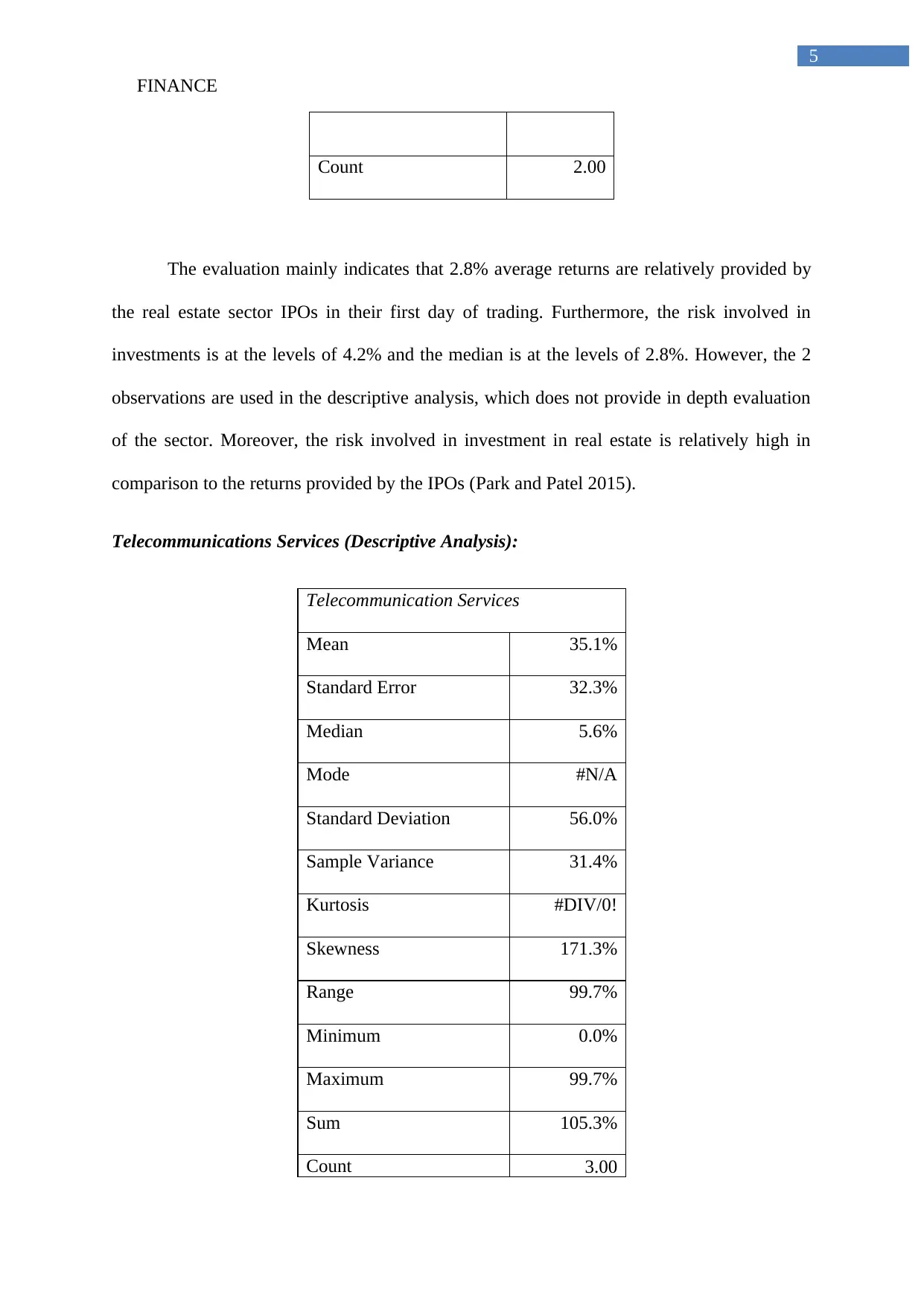
FINANCE
5
Count 2.00
The evaluation mainly indicates that 2.8% average returns are relatively provided by
the real estate sector IPOs in their first day of trading. Furthermore, the risk involved in
investments is at the levels of 4.2% and the median is at the levels of 2.8%. However, the 2
observations are used in the descriptive analysis, which does not provide in depth evaluation
of the sector. Moreover, the risk involved in investment in real estate is relatively high in
comparison to the returns provided by the IPOs (Park and Patel 2015).
Telecommunications Services (Descriptive Analysis):
Telecommunication Services
Mean 35.1%
Standard Error 32.3%
Median 5.6%
Mode #N/A
Standard Deviation 56.0%
Sample Variance 31.4%
Kurtosis #DIV/0!
Skewness 171.3%
Range 99.7%
Minimum 0.0%
Maximum 99.7%
Sum 105.3%
Count 3.00
5
Count 2.00
The evaluation mainly indicates that 2.8% average returns are relatively provided by
the real estate sector IPOs in their first day of trading. Furthermore, the risk involved in
investments is at the levels of 4.2% and the median is at the levels of 2.8%. However, the 2
observations are used in the descriptive analysis, which does not provide in depth evaluation
of the sector. Moreover, the risk involved in investment in real estate is relatively high in
comparison to the returns provided by the IPOs (Park and Patel 2015).
Telecommunications Services (Descriptive Analysis):
Telecommunication Services
Mean 35.1%
Standard Error 32.3%
Median 5.6%
Mode #N/A
Standard Deviation 56.0%
Sample Variance 31.4%
Kurtosis #DIV/0!
Skewness 171.3%
Range 99.7%
Minimum 0.0%
Maximum 99.7%
Sum 105.3%
Count 3.00
You're viewing a preview
Unlock full access by subscribing today!

FINANCE
6
The descriptive analysis of Telecommunication services sector is conducted in the
above calculation, which relatively indicates that 50% of the companies conducting the IPO
have a return higher than 35.1%. In addition, the calculation also indicates that the average
returns provided by the IPOs are the first day of trading is at the levels of 5.56%, which is
derived from the mean value of the descriptive analysis. However, the standard deviation is
mainly at the levels of 56%, which is relatively higher due to the increase returns provided by
the telecommunication service sector. Therefore, it could be understood that with higher
returns increased risk is involved in IPO initiation, which could augment risk from
investment of the investors (Brau, Cicon and McQueen 2016).
Financials (Descriptive Analysis):
Financials
Mean 17.0%
Standard Error 11.8%
Median 9.9%
Mode #N/A
Standard Deviation 29.0%
Sample Variance 8.4%
Kurtosis 78.2%
Skewness 105.7%
Range 79.3%
Minimum -12.7%
Maximum 66.7%
6
The descriptive analysis of Telecommunication services sector is conducted in the
above calculation, which relatively indicates that 50% of the companies conducting the IPO
have a return higher than 35.1%. In addition, the calculation also indicates that the average
returns provided by the IPOs are the first day of trading is at the levels of 5.56%, which is
derived from the mean value of the descriptive analysis. However, the standard deviation is
mainly at the levels of 56%, which is relatively higher due to the increase returns provided by
the telecommunication service sector. Therefore, it could be understood that with higher
returns increased risk is involved in IPO initiation, which could augment risk from
investment of the investors (Brau, Cicon and McQueen 2016).
Financials (Descriptive Analysis):
Financials
Mean 17.0%
Standard Error 11.8%
Median 9.9%
Mode #N/A
Standard Deviation 29.0%
Sample Variance 8.4%
Kurtosis 78.2%
Skewness 105.7%
Range 79.3%
Minimum -12.7%
Maximum 66.7%
Paraphrase This Document
Need a fresh take? Get an instant paraphrase of this document with our AI Paraphraser
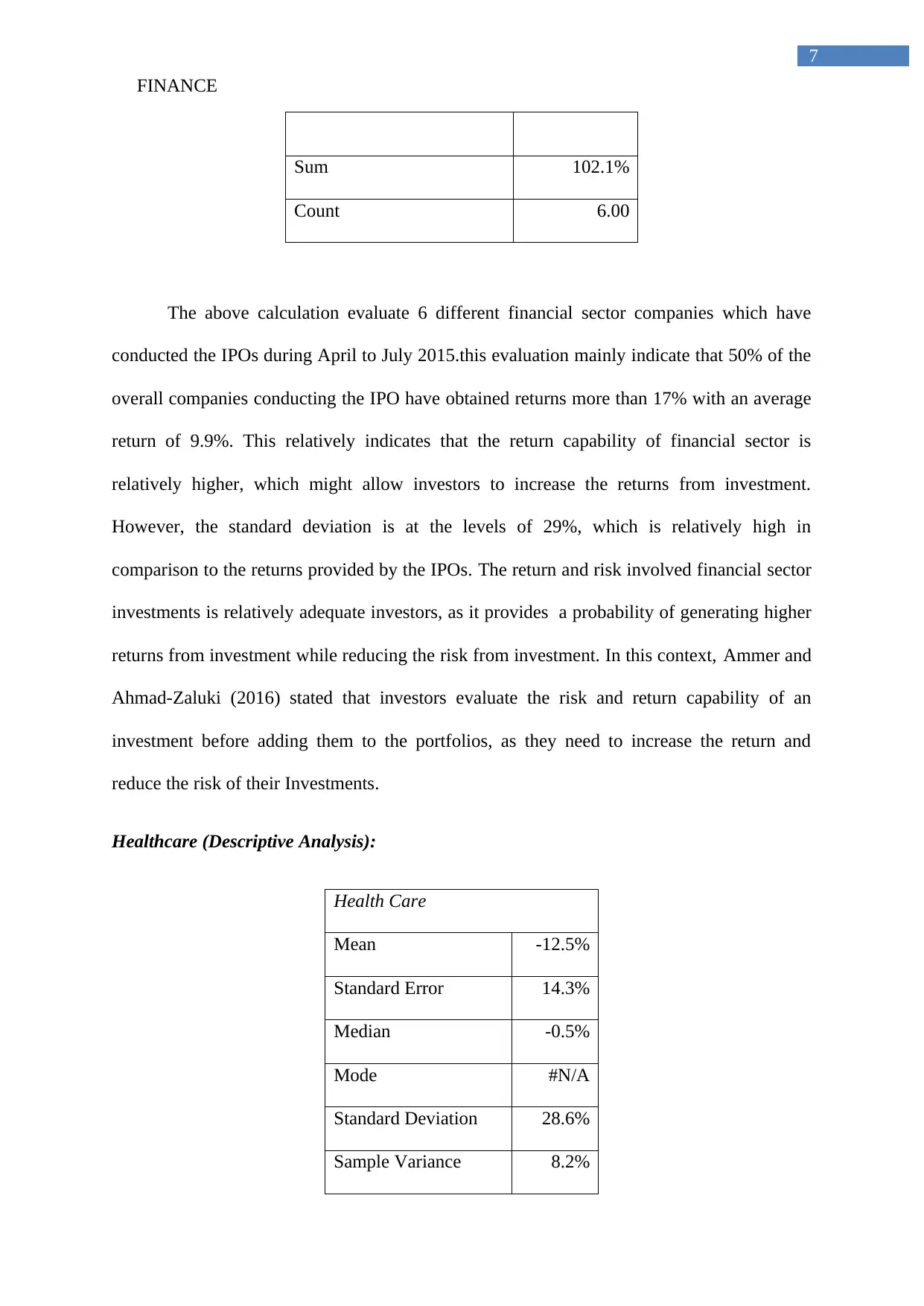
FINANCE
7
Sum 102.1%
Count 6.00
The above calculation evaluate 6 different financial sector companies which have
conducted the IPOs during April to July 2015.this evaluation mainly indicate that 50% of the
overall companies conducting the IPO have obtained returns more than 17% with an average
return of 9.9%. This relatively indicates that the return capability of financial sector is
relatively higher, which might allow investors to increase the returns from investment.
However, the standard deviation is at the levels of 29%, which is relatively high in
comparison to the returns provided by the IPOs. The return and risk involved financial sector
investments is relatively adequate investors, as it provides a probability of generating higher
returns from investment while reducing the risk from investment. In this context, Ammer and
Ahmad-Zaluki (2016) stated that investors evaluate the risk and return capability of an
investment before adding them to the portfolios, as they need to increase the return and
reduce the risk of their Investments.
Healthcare (Descriptive Analysis):
Health Care
Mean -12.5%
Standard Error 14.3%
Median -0.5%
Mode #N/A
Standard Deviation 28.6%
Sample Variance 8.2%
7
Sum 102.1%
Count 6.00
The above calculation evaluate 6 different financial sector companies which have
conducted the IPOs during April to July 2015.this evaluation mainly indicate that 50% of the
overall companies conducting the IPO have obtained returns more than 17% with an average
return of 9.9%. This relatively indicates that the return capability of financial sector is
relatively higher, which might allow investors to increase the returns from investment.
However, the standard deviation is at the levels of 29%, which is relatively high in
comparison to the returns provided by the IPOs. The return and risk involved financial sector
investments is relatively adequate investors, as it provides a probability of generating higher
returns from investment while reducing the risk from investment. In this context, Ammer and
Ahmad-Zaluki (2016) stated that investors evaluate the risk and return capability of an
investment before adding them to the portfolios, as they need to increase the return and
reduce the risk of their Investments.
Healthcare (Descriptive Analysis):
Health Care
Mean -12.5%
Standard Error 14.3%
Median -0.5%
Mode #N/A
Standard Deviation 28.6%
Sample Variance 8.2%

FINANCE
8
Kurtosis 366.9%
Skewness -190.2%
Range 61.1%
Minimum -55.1%
Maximum 6.0%
Sum -50.1%
Count 4.00
The above calculations help in evaluating the descriptive statistics of Healthcare
Companies IPOs, which is listed in the Australian index. The number of companies use for
the evaluation is 4, as the time frame used for evaluation was 4 month. In addition, the overall
returns that could be provided by Healthcare sector IPOs is relatively low, as compared to
other sectors (Nielsson and Wojcik 2016). The calculations of Mean, Median and standard
deviation relatively indicate the low return generation capability of Healthcare sector, which
might increase risk from investment while reducing the returns. The average returns of the
IPOs is at -5%, while of of the companies has introduced returns a higher than 12.5%.
Moreover, the risk involved in investment is at the levels of 28.6%, which is fairly high in
comparison to the negative returns provided by the health sector companies.
Information Technology (Descriptive Analysis):
Information Technology
Mean 9.0%
Standard Error 5.5%
Median 6.6%
Mode #N/A
8
Kurtosis 366.9%
Skewness -190.2%
Range 61.1%
Minimum -55.1%
Maximum 6.0%
Sum -50.1%
Count 4.00
The above calculations help in evaluating the descriptive statistics of Healthcare
Companies IPOs, which is listed in the Australian index. The number of companies use for
the evaluation is 4, as the time frame used for evaluation was 4 month. In addition, the overall
returns that could be provided by Healthcare sector IPOs is relatively low, as compared to
other sectors (Nielsson and Wojcik 2016). The calculations of Mean, Median and standard
deviation relatively indicate the low return generation capability of Healthcare sector, which
might increase risk from investment while reducing the returns. The average returns of the
IPOs is at -5%, while of of the companies has introduced returns a higher than 12.5%.
Moreover, the risk involved in investment is at the levels of 28.6%, which is fairly high in
comparison to the negative returns provided by the health sector companies.
Information Technology (Descriptive Analysis):
Information Technology
Mean 9.0%
Standard Error 5.5%
Median 6.6%
Mode #N/A
You're viewing a preview
Unlock full access by subscribing today!

FINANCE
9
Standard Deviation 13.5%
Sample Variance 1.8%
Kurtosis -9.9%
Skewness 55.3%
Range 38.0%
Minimum -8.0%
Maximum 30.0%
Sum 53.8%
Count 6.00
From the above devaluation descriptive analysis of Information Technology Sector
can be identified, where the mean, median and standard deviation of the returns provided by
the IPOs could be detected. In addition the oral return that is provided by Information
Technology Sector on an average is at the levels of 9%, which might allow investors to gain
exponentially during the first trading day. Moreover, 50% of the information technology
sector IPOs provided a return higher than 6.6% on the first day of trading. This relatively
indicates the credibility and return that could be generated by investors. Furthermore, with
the use of standard deviation the risk involved in investments could be identified which is at
the levels of 13.5%. Comparing the returns and risk involved in investment the Information
Technology Sector provides highly profitable IPOs, which might increase profit of the
investors while reducing risk involved in Investments (Cai and Zhu 2015).
Consumer Discretionary (Descriptive Analysis):
Consumer Discretionary
9
Standard Deviation 13.5%
Sample Variance 1.8%
Kurtosis -9.9%
Skewness 55.3%
Range 38.0%
Minimum -8.0%
Maximum 30.0%
Sum 53.8%
Count 6.00
From the above devaluation descriptive analysis of Information Technology Sector
can be identified, where the mean, median and standard deviation of the returns provided by
the IPOs could be detected. In addition the oral return that is provided by Information
Technology Sector on an average is at the levels of 9%, which might allow investors to gain
exponentially during the first trading day. Moreover, 50% of the information technology
sector IPOs provided a return higher than 6.6% on the first day of trading. This relatively
indicates the credibility and return that could be generated by investors. Furthermore, with
the use of standard deviation the risk involved in investments could be identified which is at
the levels of 13.5%. Comparing the returns and risk involved in investment the Information
Technology Sector provides highly profitable IPOs, which might increase profit of the
investors while reducing risk involved in Investments (Cai and Zhu 2015).
Consumer Discretionary (Descriptive Analysis):
Consumer Discretionary
Paraphrase This Document
Need a fresh take? Get an instant paraphrase of this document with our AI Paraphraser
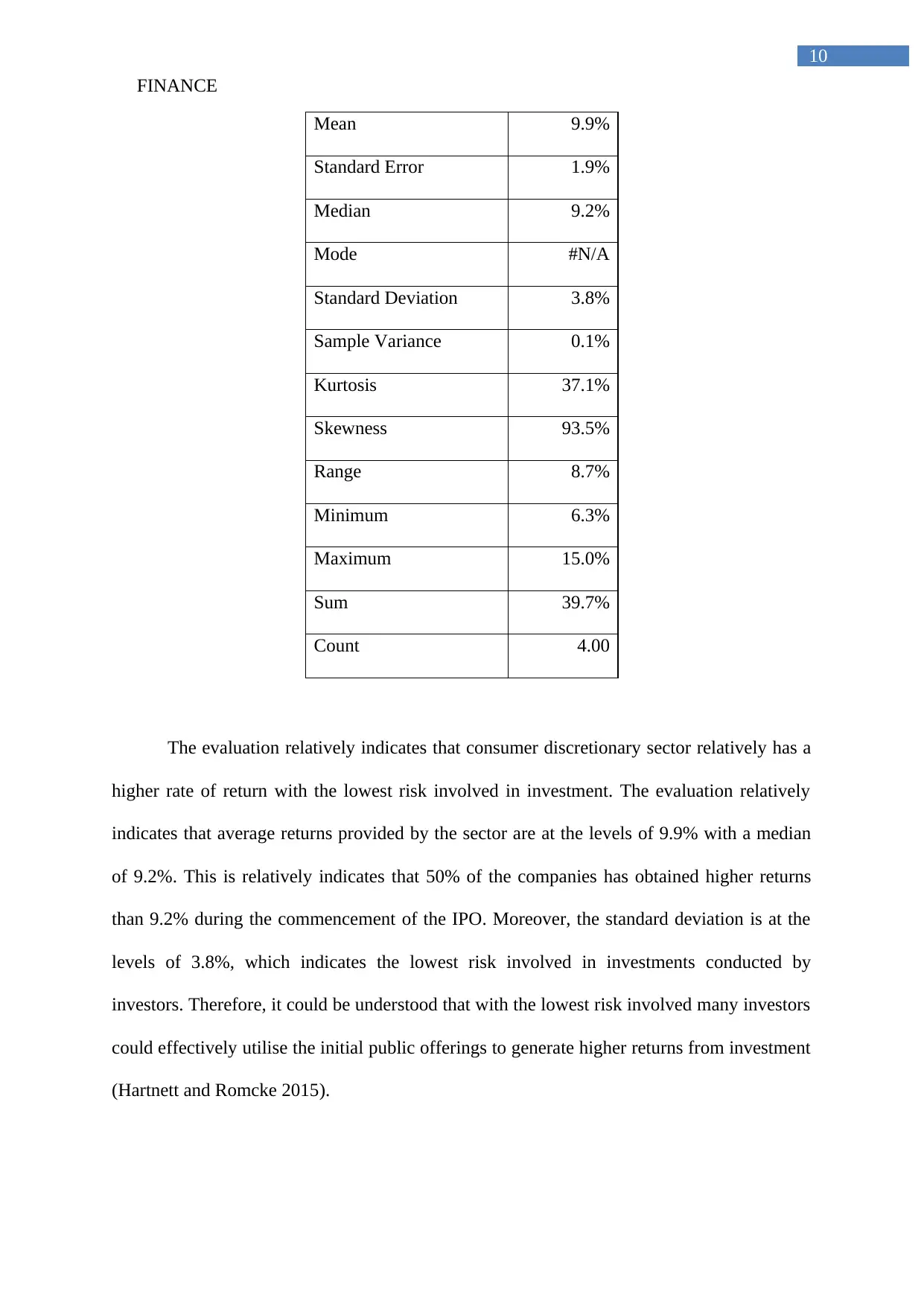
FINANCE
10
Mean 9.9%
Standard Error 1.9%
Median 9.2%
Mode #N/A
Standard Deviation 3.8%
Sample Variance 0.1%
Kurtosis 37.1%
Skewness 93.5%
Range 8.7%
Minimum 6.3%
Maximum 15.0%
Sum 39.7%
Count 4.00
The evaluation relatively indicates that consumer discretionary sector relatively has a
higher rate of return with the lowest risk involved in investment. The evaluation relatively
indicates that average returns provided by the sector are at the levels of 9.9% with a median
of 9.2%. This is relatively indicates that 50% of the companies has obtained higher returns
than 9.2% during the commencement of the IPO. Moreover, the standard deviation is at the
levels of 3.8%, which indicates the lowest risk involved in investments conducted by
investors. Therefore, it could be understood that with the lowest risk involved many investors
could effectively utilise the initial public offerings to generate higher returns from investment
(Hartnett and Romcke 2015).
10
Mean 9.9%
Standard Error 1.9%
Median 9.2%
Mode #N/A
Standard Deviation 3.8%
Sample Variance 0.1%
Kurtosis 37.1%
Skewness 93.5%
Range 8.7%
Minimum 6.3%
Maximum 15.0%
Sum 39.7%
Count 4.00
The evaluation relatively indicates that consumer discretionary sector relatively has a
higher rate of return with the lowest risk involved in investment. The evaluation relatively
indicates that average returns provided by the sector are at the levels of 9.9% with a median
of 9.2%. This is relatively indicates that 50% of the companies has obtained higher returns
than 9.2% during the commencement of the IPO. Moreover, the standard deviation is at the
levels of 3.8%, which indicates the lowest risk involved in investments conducted by
investors. Therefore, it could be understood that with the lowest risk involved many investors
could effectively utilise the initial public offerings to generate higher returns from investment
(Hartnett and Romcke 2015).
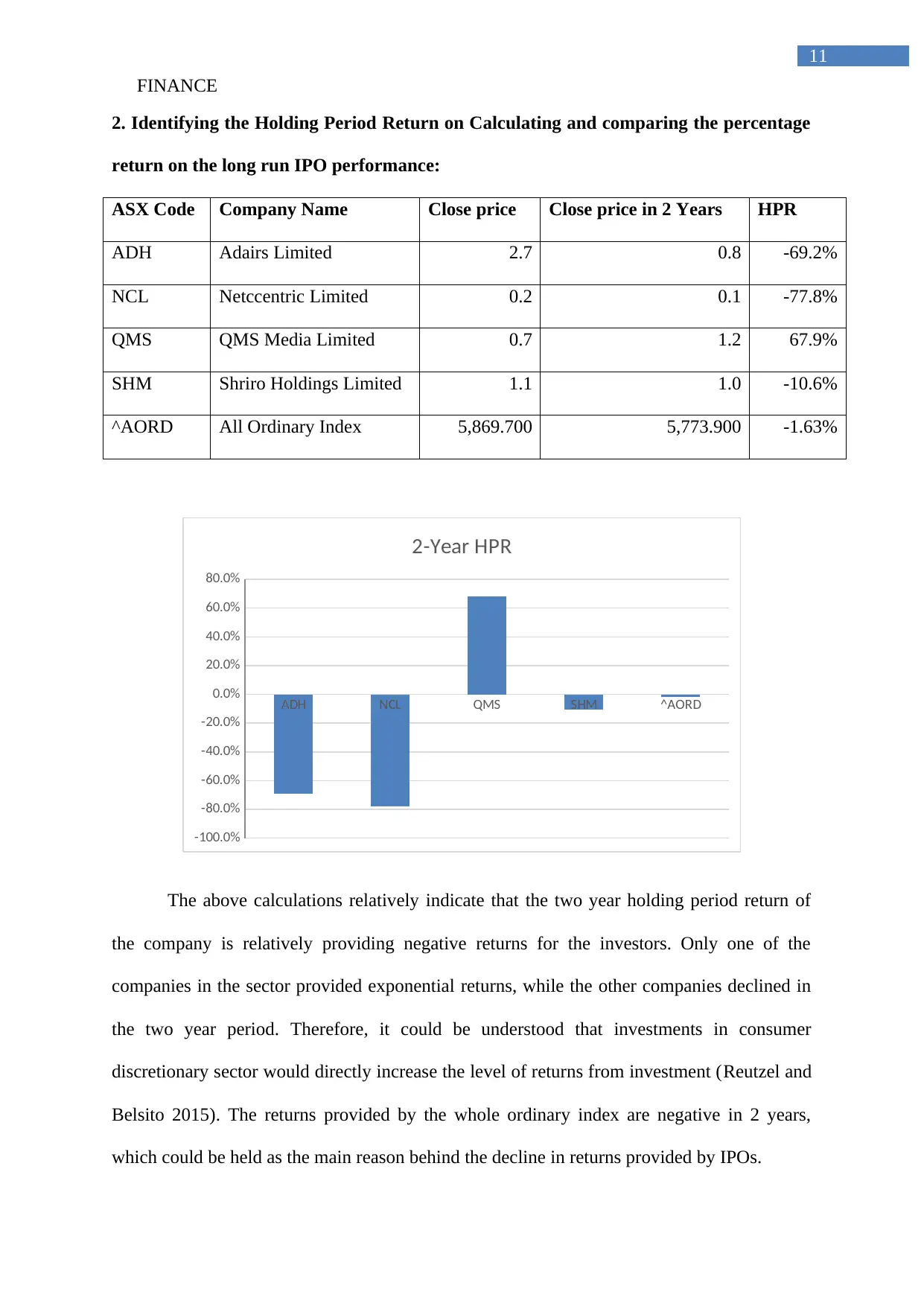
FINANCE
11
2. Identifying the Holding Period Return on Calculating and comparing the percentage
return on the long run IPO performance:
ASX Code Company Name Close price Close price in 2 Years HPR
ADH Adairs Limited 2.7 0.8 -69.2%
NCL Netccentric Limited 0.2 0.1 -77.8%
QMS QMS Media Limited 0.7 1.2 67.9%
SHM Shriro Holdings Limited 1.1 1.0 -10.6%
^AORD All Ordinary Index 5,869.700 5,773.900 -1.63%
ADH NCL QMS SHM ^AORD
-100.0%
-80.0%
-60.0%
-40.0%
-20.0%
0.0%
20.0%
40.0%
60.0%
80.0%
2-Year HPR
The above calculations relatively indicate that the two year holding period return of
the company is relatively providing negative returns for the investors. Only one of the
companies in the sector provided exponential returns, while the other companies declined in
the two year period. Therefore, it could be understood that investments in consumer
discretionary sector would directly increase the level of returns from investment (Reutzel and
Belsito 2015). The returns provided by the whole ordinary index are negative in 2 years,
which could be held as the main reason behind the decline in returns provided by IPOs.
11
2. Identifying the Holding Period Return on Calculating and comparing the percentage
return on the long run IPO performance:
ASX Code Company Name Close price Close price in 2 Years HPR
ADH Adairs Limited 2.7 0.8 -69.2%
NCL Netccentric Limited 0.2 0.1 -77.8%
QMS QMS Media Limited 0.7 1.2 67.9%
SHM Shriro Holdings Limited 1.1 1.0 -10.6%
^AORD All Ordinary Index 5,869.700 5,773.900 -1.63%
ADH NCL QMS SHM ^AORD
-100.0%
-80.0%
-60.0%
-40.0%
-20.0%
0.0%
20.0%
40.0%
60.0%
80.0%
2-Year HPR
The above calculations relatively indicate that the two year holding period return of
the company is relatively providing negative returns for the investors. Only one of the
companies in the sector provided exponential returns, while the other companies declined in
the two year period. Therefore, it could be understood that investments in consumer
discretionary sector would directly increase the level of returns from investment (Reutzel and
Belsito 2015). The returns provided by the whole ordinary index are negative in 2 years,
which could be held as the main reason behind the decline in returns provided by IPOs.
You're viewing a preview
Unlock full access by subscribing today!

FINANCE
12
Hence, from the valuation it could be identified that investors can effectively utilise
the investment scope during IPO initiation. However, the investment need to be conducted
for a short duration and cannot be kept for 2 long years, as the evaluation indicated loss from
investment. therefore, from the evaluation of the investment track record it could be
identified that investors can utilise initial IPO investment but cannot continue with the
investments for a long duration as it might hamper the investment capital and increased risk
from investment. Krigman and Jeffus (2016) stated that investors evaluate the risk and return
attributes of an investment to determine the possibility to generate higher rate of return from
their Investments.
3. Estimating the occurrence of IPO underpricing, which is been conducted in
Australian and US market by evaluating the empirical research on Hong Kong:
The information asymmetric theory and Behavioral theory could be identified, as the
main reason behind the IPO underpricing, which is been conducted in US and Australia.
Asymmetric information a relatively in the case that one of the individuals has more
information than the other, which relatively supports the IPO underpricing conducted in US
and Australian stock market. In addition, the behaviour theory also supports the underpricing
of IPO, as observation of investors is relatively different from the valuation conducted by
company and underwriters. Both the theory relatively indicates that due to the non-
availability of adequate information the behaviour of investor’s change, which directly affects
the pricing level of IPOs. Therefore, with the above theories underpricing of IPO in US and
Australia can be identified, which is the main reason behind the volatility in price during the
first day of trading (Choie 2016).
The empirical research conducted on Hong Kong share is evaluated to identify the
presence of IPO underpricing in the stock market. The researcher adequately evaluated the
12
Hence, from the valuation it could be identified that investors can effectively utilise
the investment scope during IPO initiation. However, the investment need to be conducted
for a short duration and cannot be kept for 2 long years, as the evaluation indicated loss from
investment. therefore, from the evaluation of the investment track record it could be
identified that investors can utilise initial IPO investment but cannot continue with the
investments for a long duration as it might hamper the investment capital and increased risk
from investment. Krigman and Jeffus (2016) stated that investors evaluate the risk and return
attributes of an investment to determine the possibility to generate higher rate of return from
their Investments.
3. Estimating the occurrence of IPO underpricing, which is been conducted in
Australian and US market by evaluating the empirical research on Hong Kong:
The information asymmetric theory and Behavioral theory could be identified, as the
main reason behind the IPO underpricing, which is been conducted in US and Australia.
Asymmetric information a relatively in the case that one of the individuals has more
information than the other, which relatively supports the IPO underpricing conducted in US
and Australian stock market. In addition, the behaviour theory also supports the underpricing
of IPO, as observation of investors is relatively different from the valuation conducted by
company and underwriters. Both the theory relatively indicates that due to the non-
availability of adequate information the behaviour of investor’s change, which directly affects
the pricing level of IPOs. Therefore, with the above theories underpricing of IPO in US and
Australia can be identified, which is the main reason behind the volatility in price during the
first day of trading (Choie 2016).
The empirical research conducted on Hong Kong share is evaluated to identify the
presence of IPO underpricing in the stock market. The researcher adequately evaluated the
Paraphrase This Document
Need a fresh take? Get an instant paraphrase of this document with our AI Paraphraser
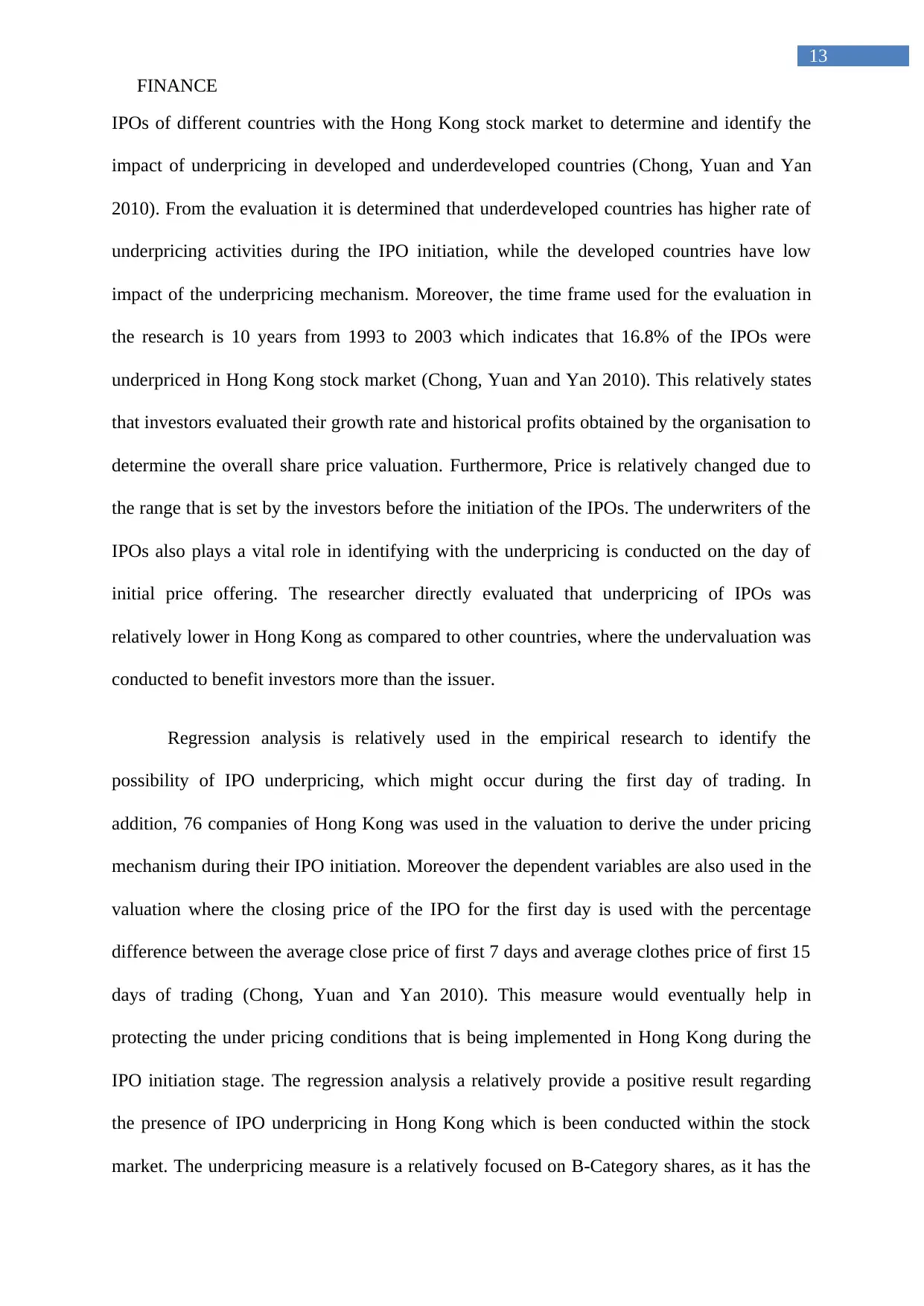
FINANCE
13
IPOs of different countries with the Hong Kong stock market to determine and identify the
impact of underpricing in developed and underdeveloped countries (Chong, Yuan and Yan
2010). From the evaluation it is determined that underdeveloped countries has higher rate of
underpricing activities during the IPO initiation, while the developed countries have low
impact of the underpricing mechanism. Moreover, the time frame used for the evaluation in
the research is 10 years from 1993 to 2003 which indicates that 16.8% of the IPOs were
underpriced in Hong Kong stock market (Chong, Yuan and Yan 2010). This relatively states
that investors evaluated their growth rate and historical profits obtained by the organisation to
determine the overall share price valuation. Furthermore, Price is relatively changed due to
the range that is set by the investors before the initiation of the IPOs. The underwriters of the
IPOs also plays a vital role in identifying with the underpricing is conducted on the day of
initial price offering. The researcher directly evaluated that underpricing of IPOs was
relatively lower in Hong Kong as compared to other countries, where the undervaluation was
conducted to benefit investors more than the issuer.
Regression analysis is relatively used in the empirical research to identify the
possibility of IPO underpricing, which might occur during the first day of trading. In
addition, 76 companies of Hong Kong was used in the valuation to derive the under pricing
mechanism during their IPO initiation. Moreover the dependent variables are also used in the
valuation where the closing price of the IPO for the first day is used with the percentage
difference between the average close price of first 7 days and average clothes price of first 15
days of trading (Chong, Yuan and Yan 2010). This measure would eventually help in
protecting the under pricing conditions that is being implemented in Hong Kong during the
IPO initiation stage. The regression analysis a relatively provide a positive result regarding
the presence of IPO underpricing in Hong Kong which is been conducted within the stock
market. The underpricing measure is a relatively focused on B-Category shares, as it has the
13
IPOs of different countries with the Hong Kong stock market to determine and identify the
impact of underpricing in developed and underdeveloped countries (Chong, Yuan and Yan
2010). From the evaluation it is determined that underdeveloped countries has higher rate of
underpricing activities during the IPO initiation, while the developed countries have low
impact of the underpricing mechanism. Moreover, the time frame used for the evaluation in
the research is 10 years from 1993 to 2003 which indicates that 16.8% of the IPOs were
underpriced in Hong Kong stock market (Chong, Yuan and Yan 2010). This relatively states
that investors evaluated their growth rate and historical profits obtained by the organisation to
determine the overall share price valuation. Furthermore, Price is relatively changed due to
the range that is set by the investors before the initiation of the IPOs. The underwriters of the
IPOs also plays a vital role in identifying with the underpricing is conducted on the day of
initial price offering. The researcher directly evaluated that underpricing of IPOs was
relatively lower in Hong Kong as compared to other countries, where the undervaluation was
conducted to benefit investors more than the issuer.
Regression analysis is relatively used in the empirical research to identify the
possibility of IPO underpricing, which might occur during the first day of trading. In
addition, 76 companies of Hong Kong was used in the valuation to derive the under pricing
mechanism during their IPO initiation. Moreover the dependent variables are also used in the
valuation where the closing price of the IPO for the first day is used with the percentage
difference between the average close price of first 7 days and average clothes price of first 15
days of trading (Chong, Yuan and Yan 2010). This measure would eventually help in
protecting the under pricing conditions that is being implemented in Hong Kong during the
IPO initiation stage. The regression analysis a relatively provide a positive result regarding
the presence of IPO underpricing in Hong Kong which is been conducted within the stock
market. The underpricing measure is a relatively focused on B-Category shares, as it has the
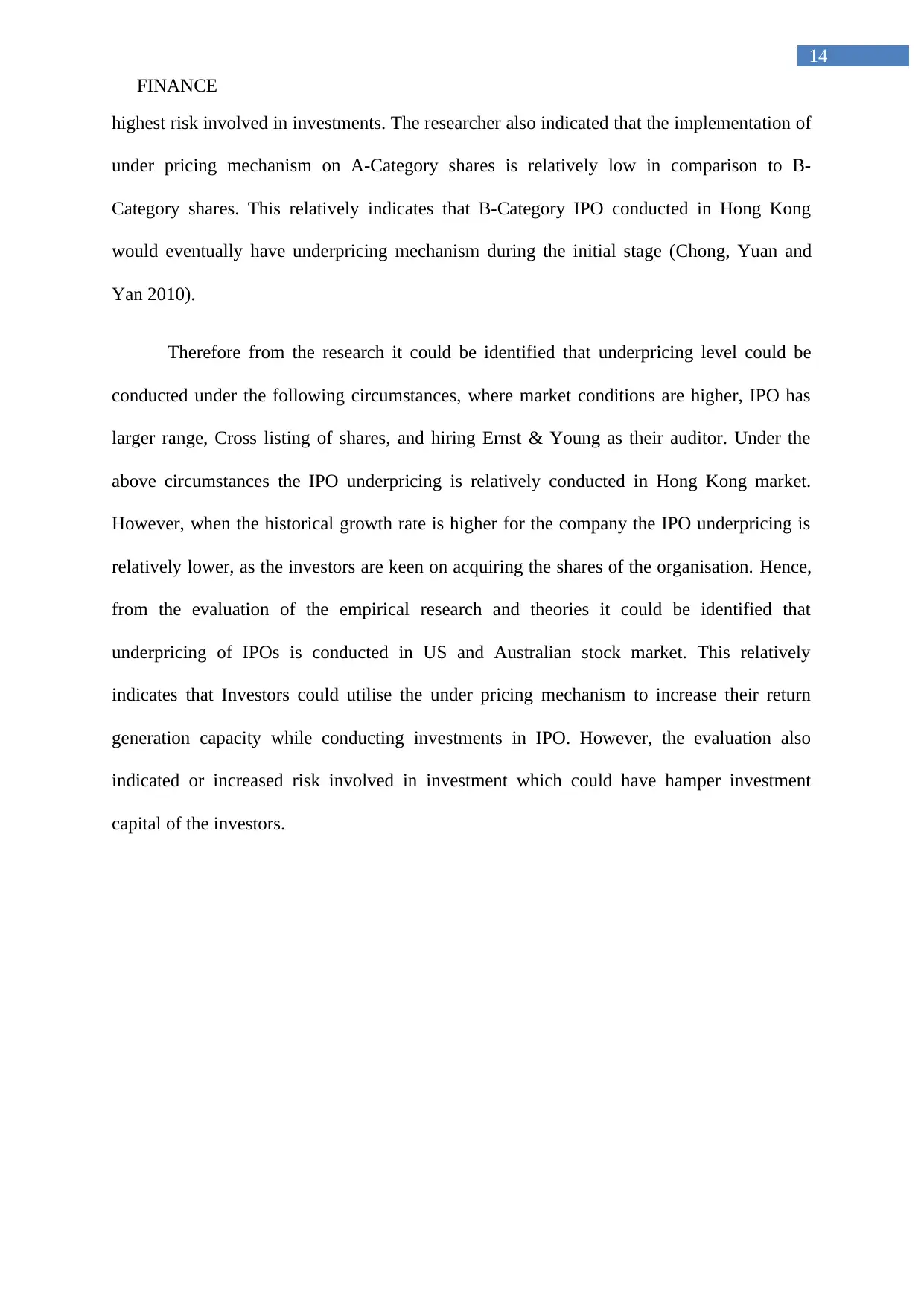
FINANCE
14
highest risk involved in investments. The researcher also indicated that the implementation of
under pricing mechanism on A-Category shares is relatively low in comparison to B-
Category shares. This relatively indicates that B-Category IPO conducted in Hong Kong
would eventually have underpricing mechanism during the initial stage (Chong, Yuan and
Yan 2010).
Therefore from the research it could be identified that underpricing level could be
conducted under the following circumstances, where market conditions are higher, IPO has
larger range, Cross listing of shares, and hiring Ernst & Young as their auditor. Under the
above circumstances the IPO underpricing is relatively conducted in Hong Kong market.
However, when the historical growth rate is higher for the company the IPO underpricing is
relatively lower, as the investors are keen on acquiring the shares of the organisation. Hence,
from the evaluation of the empirical research and theories it could be identified that
underpricing of IPOs is conducted in US and Australian stock market. This relatively
indicates that Investors could utilise the under pricing mechanism to increase their return
generation capacity while conducting investments in IPO. However, the evaluation also
indicated or increased risk involved in investment which could have hamper investment
capital of the investors.
14
highest risk involved in investments. The researcher also indicated that the implementation of
under pricing mechanism on A-Category shares is relatively low in comparison to B-
Category shares. This relatively indicates that B-Category IPO conducted in Hong Kong
would eventually have underpricing mechanism during the initial stage (Chong, Yuan and
Yan 2010).
Therefore from the research it could be identified that underpricing level could be
conducted under the following circumstances, where market conditions are higher, IPO has
larger range, Cross listing of shares, and hiring Ernst & Young as their auditor. Under the
above circumstances the IPO underpricing is relatively conducted in Hong Kong market.
However, when the historical growth rate is higher for the company the IPO underpricing is
relatively lower, as the investors are keen on acquiring the shares of the organisation. Hence,
from the evaluation of the empirical research and theories it could be identified that
underpricing of IPOs is conducted in US and Australian stock market. This relatively
indicates that Investors could utilise the under pricing mechanism to increase their return
generation capacity while conducting investments in IPO. However, the evaluation also
indicated or increased risk involved in investment which could have hamper investment
capital of the investors.
You're viewing a preview
Unlock full access by subscribing today!

FINANCE
15
Reference and Bibliography:
Ammer, M.A. and Ahmad-Zaluki, N.A., 2016. The effect of underwriter’s market share,
spread and management earnings forecasts bias and accuracy on underpricing of Malaysian
IPOs. International Journal of Managerial Finance, 12(3), pp.351-371.
Au.finance.yahoo.com. (2018). ^AORD Historical prices | ALL ORDINARIES Stock - Yahoo
Finance. [online] Available at: https://au.finance.yahoo.com/quote/%5EAORD/history?
period1=1427826600&period2=1501439400&interval=1d&filter=history&frequency=1d
[Accessed 29 Apr. 2018].
Bidwell, M., Won, S., Barbulescu, R. and Mollick, E., 2015. I used to work at Goldman
Sachs! How firms benefit from organizational status in the market for human
capital. Strategic Management Journal, 36(8), pp.1164-1173.
Bouzouita, N., Gajewski, J.F. and Gresse, C., 2015. Liquidity benefits from IPO
underpricing: ownership dispersion or information effect. Financial Management, 44(4),
pp.785-810.
Bradley, D., Kim, I. and Krigman, L., 2015. Top VC IPO underpricing. Journal of Corporate
Finance, 31, pp.186-202.
Brailsford, T., Heaney, R., Powell, J. and Jing, S., 2015. Hot and cold IPO markets:
identification using a regime switching model.
Brau, J.C., Cicon, J. and McQueen, G., 2016. Soft strategic information and IPO
underpricing. Journal of Behavioral Finance, 17(1), pp.1-17.
Brown, D., 2016. Investing in Security Price Informativeness: The Role of IPO Underpricing.
15
Reference and Bibliography:
Ammer, M.A. and Ahmad-Zaluki, N.A., 2016. The effect of underwriter’s market share,
spread and management earnings forecasts bias and accuracy on underpricing of Malaysian
IPOs. International Journal of Managerial Finance, 12(3), pp.351-371.
Au.finance.yahoo.com. (2018). ^AORD Historical prices | ALL ORDINARIES Stock - Yahoo
Finance. [online] Available at: https://au.finance.yahoo.com/quote/%5EAORD/history?
period1=1427826600&period2=1501439400&interval=1d&filter=history&frequency=1d
[Accessed 29 Apr. 2018].
Bidwell, M., Won, S., Barbulescu, R. and Mollick, E., 2015. I used to work at Goldman
Sachs! How firms benefit from organizational status in the market for human
capital. Strategic Management Journal, 36(8), pp.1164-1173.
Bouzouita, N., Gajewski, J.F. and Gresse, C., 2015. Liquidity benefits from IPO
underpricing: ownership dispersion or information effect. Financial Management, 44(4),
pp.785-810.
Bradley, D., Kim, I. and Krigman, L., 2015. Top VC IPO underpricing. Journal of Corporate
Finance, 31, pp.186-202.
Brailsford, T., Heaney, R., Powell, J. and Jing, S., 2015. Hot and cold IPO markets:
identification using a regime switching model.
Brau, J.C., Cicon, J. and McQueen, G., 2016. Soft strategic information and IPO
underpricing. Journal of Behavioral Finance, 17(1), pp.1-17.
Brown, D., 2016. Investing in Security Price Informativeness: The Role of IPO Underpricing.
1 out of 16
Related Documents
Your All-in-One AI-Powered Toolkit for Academic Success.
+13062052269
info@desklib.com
Available 24*7 on WhatsApp / Email
![[object Object]](/_next/static/media/star-bottom.7253800d.svg)
Unlock your academic potential
© 2024 | Zucol Services PVT LTD | All rights reserved.





